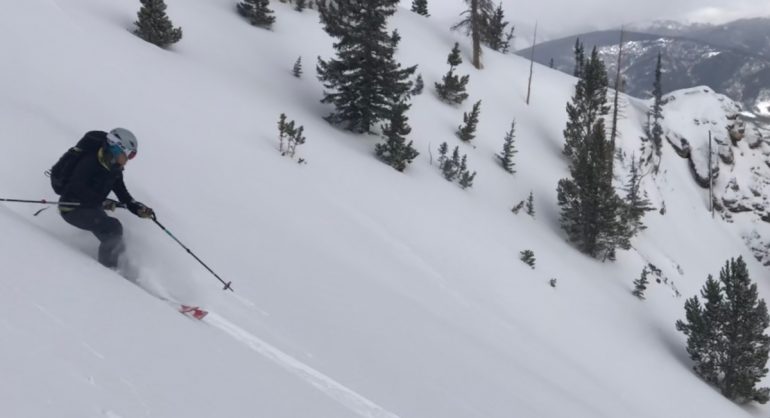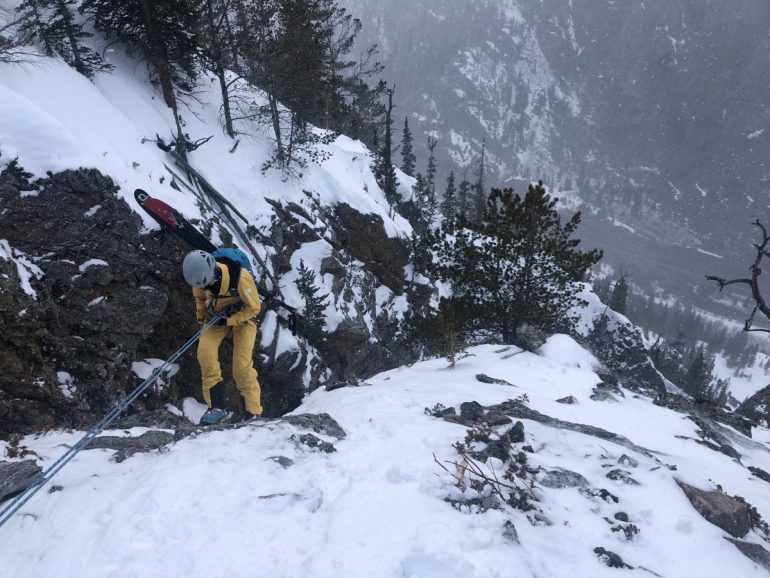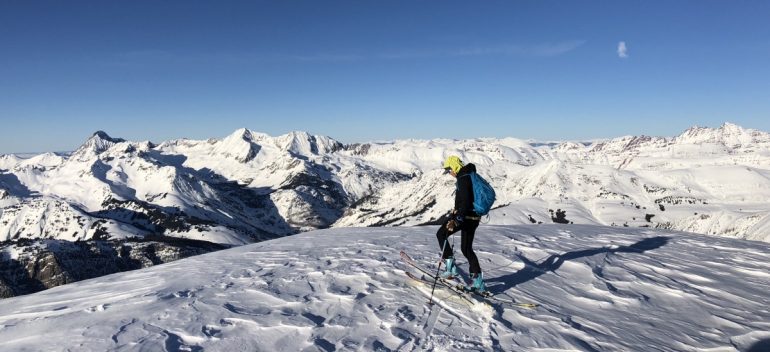
Fun and floaty in powder but able and smooth in crud, the Cassiar 95 Tour1 could be the ski for the woman who wants it all.
For women skiers, consider the nimble, versatile Cassiar 95 Tour1
As I entered my sixth straight hour of ski touring, the 13,535 ft summit of Treasure Mountain in the West Elk Mountains of Colorado loomed impossibly out of sight above me. I shuffled up the skin track, a 10-step count rotating in my mind. Earlier that day, my crew and I had tagged another peak in the area, attempted a failed ridge traverse and enjoyed some nice powder turns to the valley floor. My watch told me we were at 7000 feet of climbing for the day and we still had at least 1000 feet to go.
Jump to the Cassiar 95s in action.
Summary: The Cassiar 95 Tour1 is part of DPS’s Tour series, developed with the intent to offer exceptional downhill performance in a light touring ski. They achieve this by layering ultralight balsa wood with carbon fiber and wrapping it with cap construction. The result: a feathery, versatile touring ski that can rip and carries a slightly lower price tag than DPS’s other offerings.
Ideal Pairing: The everyday tourer without a bottomless quiver budget who wants an efficient ski for the up and down. While DPS makes a woman’s ski, I’d argue the Cassiar 95s are a great option for women who want to have a powder stick and ski mountaineering tool in one.
Sizing: At 5’6” and 115lbs, I found the 168s to be just short enough and would have liked to try them a hair shorter. Other option: 178cm.
Similar Skis Tested: Voile HyperVector, DPS Zelda 106 Tour1. The Zelda is essentially the Wailer 106 painted purple. The DPS 106 is designed to be an all around charger erring towards powder, but for lighter skiers this is borderline too fat to be considered all mountain. The 95 keeps the shape and positive attributes but in a tighter package.
Product Highlights: One: the balsa core combined with a hint of carbon equals a light ski that’s easy on the chatter. Two: in the Cassiar series, DPS toned down their characteristic rocker and flattened the tail. This makes for snappy, smooth turn initiation and solid edge control.
Gripes: The 168 came close enough to my ideal length, except in tight trees or on long skates when I found myself repeatedly crossing my tails (admittedly, perhaps a testament to poor skating technique). To have a full women’s offering it should be made in shorter lengths.
Durability: After six months of constant touring in all kinds of conditions, they’ve got scratches on the top sheets and a couple of scrapes on the bases but nothing major. DPS finished the skis with World Cup bases and Rockwell edges to help increase durability. I look forward to seeing how they hold up over the next season.
Boot/Binding/Skin Combination: Scarpa F1, Dynafit Speed Radical, Pomoca Climb 2.0
SPECS
Weight – 1375g/178cm, 1220g/168cm
Available lengths – 168cm, 178cm
Dimensions – 129mm Tip, 95mm Waist 116mm Tail
Core – Balsa/Carbon Fiber
Profile – rockered tip, early rise tail, camber
MSRP – $1,099
Where to buy: CrippleCreekbc.com, Backcountry.com
The Cassiar 95 Tour1 in Action
The tour and summit of Treasure were the culmination of a hard week spent training for my first Grand Elk Traverse ski race. Earlier that week, I’d done two big tours, intervals and a day of resort powder skiing, all on my Cassiar 95s. The Treasure tour would be the biggest effort of the week, after which I’d give my body a well-deserved break. My legs were ready for it.
As mentioned above, I’m a relatively light person well acquainted with being tossed around by ultralight skis in variable conditions. I was initially unsure whether I’d enjoy a carbon composite ski, as I’d repeatedly heard reports that carbon makes skis extra stiff, which I interpreted to mean they’d give a rough ride to smaller folks like myself. But, I wanted something light that could, dare I say it, do it all. A daily driver with the versatility to manage all varieties of ski mountaineering ascents and descents while skiing fun and floaty when fresh snow swallowed the measuring stick.
Over the course of six months with the Cassiar, I skied nearly every possible condition. From wind hammered Wyoming peaks, pillowy cold Colorado powder, northwest volcano corn snow, chunky steep resort bumps, late summer Rocky Mountain slush, and even the occasional “sagebrush slalom,” a southeast Wyoming special. The Cassiar has shown up in fine form for all of it and I’ve had no notable issues commanding the ski even in the most variable conditions.

Throughout the season, I spent a lot of time with the Cassiar 95’s on my back, sometimes going down instead of up.
Speaking of variable conditions, by the time we reached the top of Treasure’s long, rounded summit ridge, the sun hovered on the western ridgeline across the valley. We unceremoniously pulled skins, realizing that our 4000 ft descent was quickly slipping into shadow. The top section offered buttery, sun-softened snow that the Cassiars effortlessly arced down. About midway, we hit full shadow and the resulting sun crust. Fun skiing morphed into survival. But, the Cassiars handled it. Reliable and stable, but incredibly light and responsive, I was able to skim the breakable crust, only letting my edges penetrate it enough to transition between turns.
Lower down, the snow got weird. Old avalanche debris disguised by crusty snow made for mini land mines. My legs were tired and I briefly considered how a heavier softer ski would just plow through… But the Cassiars soldiered on, the edges grabbing and turning and absorbing the rollicking ride when needed. We slipped into thick trees for soft reprieve before getting spat into a mellow aspen run that funneled us into a creek where we transitioned back onto skins for the final climb back to the truck.
In the Tour1 series, DPS set out to create a lightweight ski that would perform as well on the up as the down. My day on Treasure illuminated those qualities and more in the Cassiar 95. Throughout the day, my partners and I moved regularly between skis under foot and skis on the pack, even with a short spicy hands and feet climb up a rock rib. Light for the carrying and the skinning, the skis offered fun and engaging descents that keep me reaching for them.
Editor’s note: For more on the Cassiar 95 Tour1, read Bob Perlmutter’s post.
Manasseh Franklin is a writer, editor and big fan of walking uphill. She has an MFA in creative nonfiction and environment and natural resources from the University of Wyoming and especially enjoys writing about glaciers. Find her other work in Alpinist, Adventure Journal, Rock and Ice, Aspen Sojourner, AFAR, Trail Runner and Western Confluence.


